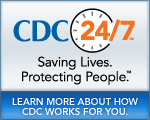MMWR
Morbidity and Mortality Weekly Report
Synopsis for May 29, 2008
- Fatal Primary Amebic Meningoencephalitis Caused by Naegleria fowleri — Arizona, Florida, and Texas, 2007
- Detection of West Nile Virus in Blood Donations — Puerto Rico, 2007
- Guiding Principles for Development of ACIP Recommendations for Vaccination During Pregnancy and Breastfeeding
There is no MMWR telebriefing scheduled for:
May 29, 2008
Fatal Primary Amebic Meningoencephalitis Caused by Naegleria fowleri — Arizona, Florida, and Texas, 2007
PRESS CONTACT: CDC
Division of Media Relations
(404) 639-3286
PAM is a tragic and nearly always fatal illness. The rare number of infections considering the millions of people using the same or similar waters across the U.S. makes development of science-based prevention recommendations difficult. In 2007, six fatal cases of Primary Amebic Meningoencephalitis (PAM) occurred. This nearly always fatal infection is caused by Naegleria fowleri. N. fowleri is a warm water-loving ameba naturally found in freshwater lakes, rivers, and hot springs. Infection occurs when water containing N. fowleri goes up the nose to the brain where it causes fatal damage. A review of previous infection reports showed that 121 PAM infections occurred over the last 71 years. Nearly all people died after swimming in warm, freshwater in these 15 southern-tier states (AZ, AR, CA, FL, GA, LA, MS, MO, NE, NM, NC, OK, SC, TX, and VA). Median age of infection was 12 years old and almost three quarters of cases were in males. The most common months for infection (85 percent) were July, August, and September.
Detection of West Nile Virus in Blood Donations — Puerto Rico, 2007
PRESS CONTACT: CDC
Division of Media Relations
(404) 639-3286
West Nile Virus infection was identified for the first time in routine screening of blood donors in Puerto Rico during 2007. Blood donations have been routinely screened for West Nile Virus (WNV) in the US and Puerto Rico since 2003. During 2007, WNV was identified for the first time in blood donors from Puerto Rico. Even though the blood donations from three people were positive for WNV, these individuals did not report being sick in the two weeks prior to or after they donated blood. Their blood donations were removed from the blood supply and were not used. In Puerto Rico surveillance for human neuroinvasive WNV infections has been conducted since 2002. No cases of neuroinvasive WNV infections have been detected in Puerto Rico. The Puerto Rico Department of Health and the Centers for Disease Control and Prevention are continuing surveillance for human WNV infections in 2008.
Guiding Principles for Development of ACIP Recommendations for Vaccination During Pregnancy and Breastfeeding
PRESS CONTACT: CDC
Division of Media Relations
(404) 639-3286
ACIP has approved “Guiding Principles in Development of ACIP Recommendations for Vaccination during Pregnancy and Breastfeeding,” to promote a consistent process and uniform terminology in development of vaccination recommendations for pregnant and breastfeeding women. The document is available on the web at http://www.cy118119.com/vaccines/recs/acip/default.htm. Because there is limited scientific evidence to guide formulation of policy for vaccinating pregnant and breastfeeding women, the Advisory Committee on Immunization Practices (ACIP) established in 2007 the Work Group on Vaccines during Pregnancy and Breastfeeding. The Work Group developed “Guiding Principles in Development of ACIP Recommendations for Vaccination during Pregnancy and Breastfeeding” to provide guidance and to help standardize presentation of rationale for policy development of vaccine recommendations for pregnant and breastfeeding women.
####
- Historical Document: May 29, 2008
- Content source: Office of Enterprise Communication
- Notice: Links to non-governmental sites do not necessarily represent the views of the CDC.
View Press Releases in
Get e-mail updates
To receive e-mail updates about this page, enter your
e-mail address:
Contact Us:
- Centers for Disease Control and Prevention
1600 Clifton Rd
Atlanta, GA 30333 - 800-CDC-INFO
(800-232-4636)
TTY: (888) 232-6348 - Contact CDC-INFO


